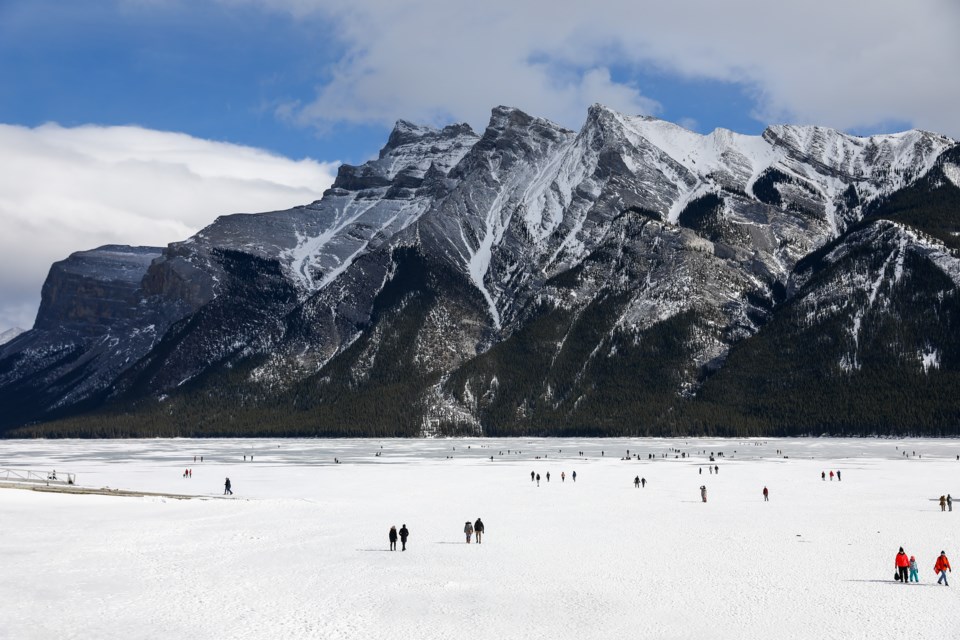BOW VALLEY – The tourism sector will have a pivotal role as part of Alberta’s economic recovery from COVID-19.
As part of the 2021 budget, the province will create and implement an ambitious Tourism Recovery Plan that will aim to double tourism spending to more than $16 billion a year by 2030.
“It’s a positive,” Rachel Ludwig, the interim CEO of Tourism Canmore Kananaskis, said. “The addition of funding for Travel Alberta is needed. The tourism sector has been hit the hardest by the pandemic and will likely take the longest to recover. We really need Travel Alberta to lead us out of this crisis and into recovery mode.”
However, it’s not yet known what role the Bow Valley – one of the most popular tourist locations in Canada – will play in the plan.
While more information is to be revealed, Banff and Lake Louise Tourism are seeing the planned additional funding as a positive.
“We are very pleased to see an increase in budget to support the tourism industry in Alberta,” Leslie Bruce, the president and CEO of the tourism organization, said. “Our industry is the hardest hit with the pandemic and needs this support along with continued support from all levels of government at least until we achieve mass vaccination and the final restrictions begin to ease.
“Our community in Banff and Lake Louise relies solely on tourism and there is still a long road ahead to rebuilding our economy here.”
The David Thompson corridor – Highway 11 and running from Red Deer to Rocky Mountain House and intersecting with the Icefields Parkway on Highway 93 – will also get $8.4 million to upgrade tourism and recreation sites.
According to Invest Alberta, a Crown corporation dedicated to attracting investment to the province, tourism annually contributes $8 billion in revenue and more than 36 million visitors.
The most recently completed Statistics Canada Travel Survey of Residents of Canada study in 2018 had $8.2 billion spent on tourism and 35.2 million visits.
Travel Alberta also estimated there were 68,800 tourism-based jobs in Alberta during 2018 and roughly 20,000 tourism-related businesses.
Ludwig said research has also shown when Albertans visit the region, the average person spends $298 while an international visitor – one who is likely to visit much less than someone in the province – averages about $949 per person.
She said they’re aiming to attract higher spending visitors, but also find ways to attract people in the off-peak season.
“There’s a lot of traffic and visitation in the summer, but it falls in winter and shoulder seasons. That’s where a lot of the growth can happen. … There are so many unknowns why we haven’t seen the growth and we’re trying to figure that piece out.”
The budget highlighted the significant impact COVID-19 and travel restrictions had on tourism. The government’s tourism levy revenue was forecasted to decrease from an estimated $92 million collected in the previous budget to $25 million from March 1, 2020 to March 31, 2021.
The levy’s revenue is collected from hotels and other lodgings, but an abatement – which is continuing until March 31 – from the government allowed those businesses to keep the revenue.
It was noted in the budget that recovery in the tourism sector – which is estimated to not return to the $92 million in levy revenue until 2023-24 – is likely to be reliant on mass vaccinations.
Travel Alberta will also evolve into a destination marketing organization, including destination and product development, research and promotion.
A senior representative for tourism investment and parks liaison position was created for Invest Alberta. Canmore resident Dave Rodney has been appointed to that position by the government.
Rodney was a conservative MLA from 2004-17, winning four elections. He resigned his seat for Calgary-Lougheed, paving the way for Jason Kenney to run in the byelection after he became leader of the United Conservative Party.
He’s also the former head of the tourism board in Canmore-Kananaskis and also served on Travel Alberta’s Strategic Tourism Marketing Council and the Calgary Stampede Board.
“His knowledge of the sector and opportunities, as well as the environmental and local considerations that are needed to be taken into account when identifying and moving forward with tourism projects is incredibly beneficial,” David Knight Legg, Invest Alberta’s CEO, said in an email.
While more visitors will bring more revenue into the province, it will also add more infrastructure needs. The province collects four per cent from each booking at hotels – homestays such as Airbnb will begin this year – it goes into general revenues for the province; however, the municipality is left to foot the infrastructure bills.
The Towns of Canmore, Banff and Jasper have been lobbying the province for the past decade to bring in a type of resort municipality status, which exist in some regions in Prince Edward Island and British Columbia. The status would allow them to collect tourism-based revenue – similar to the provincial tourism levy – to help local needs.
Over that time period, they’ve commissioned three studies and reports, met with 20 provincial ministers and developed position papers to amend the Municipal Government Act.
“The communities who welcome the visitors have additional infrastructure needs,” Ludwig said. “There’s no funding mechanism to get additional funding from the province.”
Banff National Park estimated visitors
- 2015-16: 3,894,332
- 2016-17: 4,059,503
- 2017-18: 4,181,854
- 2018-19: 4,089,309
- 2019-20: 4,121,062
Kananaskis Country Provincial Park estimated visitors
- 2015: 3,597,678
- 2016: 3,706,633
- 2017: 3,733,772
- 2018: 3,793,782
- 2019: 4,103,965
- 2020: 5,394,168
Canmore Nordic Centre and Spray Valley Provincial Parks estimated visitors
- 2015: 828,921
- 2016: 856,043
- 2017: 856,903
- 2018: 1,082,773
- 2019: 1,141,093
- 2020: 1,238,146
Provincial tourism levy
- 2019: $89 million collected
- 2020: $92 million budgeted and $25 million collected
- 2021: $62 million estimated to be collected
- 2022: $82 million estimated to be collected
- 2023: $92 million estimated to be collected


